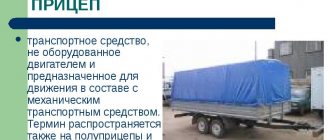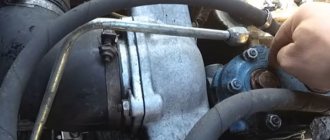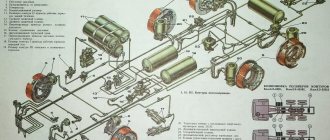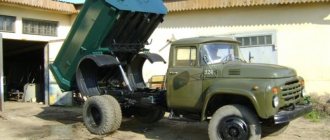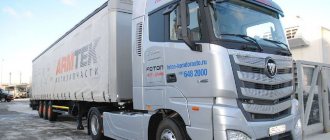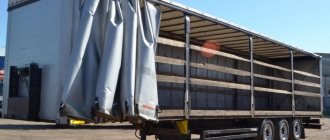How to choose a truck
Not all equipment is equally suitable for transporting different types of cargo. One category is good for use in city mode, the other is better for intercity routes. Take into account a number of parameters that make it easier to choose a used car:
- type of vehicle;
- load capacity;
- body type;
- technical condition.
It is not necessary to consider all criteria at once. Having an idea of the purpose of the truck, choosing from many options will not be difficult.
Type of vehicle
They include transport trucks and special-purpose equipment. The first category is divided into general purpose trucks, transporting various products, excluding liquids, and specialized vehicles, delivering specific goods.
The range of specialized equipment includes:
- dump trucks;
- vans (including those transporting animals and birds, food, manufactured goods);
- transporting building materials;
- vehicles transporting containers;
- vehicles transporting long cargo;
- tanks for transporting solutions, chemical and petroleum products, household waste, liquid food, gases.
- transport vehicles, etc.
And this is only part of a large list of goods that a vehicle can be used to transport.
Requirements for the transport of dangerous goods by road
First, you need to determine which products and substances are considered dangerous. According to the traffic rules, these include:
- poisons;
- cargo with increased explosion hazard;
- substances that provoke oxidation;
- flammable and spontaneously combustible liquids or solids;
- compressed gaseous substances;
- cargo with increased radioactivity;
- caustic substances that cause corrosion.
These types of cargo pose a danger to the environment. They can pollute the air, atmosphere, water, and also cause serious harm to human health and even pose a danger to life. Therefore, this type of transportation is subject to special requirements from the current traffic rules:
- Does the enterprise have a license?
Its receipt is regulated at the level of legislation of the Russian Federation.
- Transportation permit
It must be issued to the responsible person in the local authorities of Gosatomnadzor of Russia.
- Certificate for the vehicle
The vehicle must be marked as suitable for transporting this type of dangerous cargo. When transporting certain types of cargo, the body must be painted in a certain color or have inscriptions ("Corrosive substance", "Ammonia water"; methanol - orange body with a black stripe, spontaneously combustible materials - red, etc.)
- Completion of training
The enterprise is obliged to provide instructions to drivers on the rules for transporting certain hazardous substances.
Place an order for tachograph cards.
- Path negotiation
The movement of a truck transporting particularly dangerous substances is carried out along a strictly designated route drawn up by the transport company.
Do you still have questions?
Call right now 8-800-511-81-93 or write to us back to contents
Car load capacity
In order to select equipment based on its carrying capacity, it is necessary to take into account the quantity and dimensions of the delivered product. According to this parameter, trucks are divided into several types:
- Small-tonnage. Designed for transporting cargo up to 3 tons - products, construction materials and other oversized goods. The transport is often used as a cargo taxi.
- Medium-tonnage. The load capacity of the machines ranges from 3 to 5 tons. Trucks have a mandatory parameter for body volume - 35 cubic meters.
- Large-tonnage. Load capacity ranges from 5 tons and above. The body must be at least 80 cubic meters. Such vehicles include trucks and long-length vehicles; they are used in increased cargo transportation by retail chains, markets, etc.
This parameter is considered a priority when considering options for used vehicles. Having purchased a vehicle with insufficient carrying capacity, there is a high probability that fulfilling large orders will be unavailable.
Machineless and machine methods of cooling cargo in refrigerated trucks
In the machine-free method of cooling cargo in the cargo areas of refrigerated trucks, solid carbon dioxide (dry ice), frozen eutectic solutions (sodium or potassium chloride, etc.) and liquefied gases (liquid carbon dioxide, liquid nitrogen) are used.
Sublimation of dry ice (transition from a solid to a gaseous state) allows you to achieve low temperatures inside the van (body). The high density (1500 kg/m3) of dry ice allows the creation of compact refrigerated units. Dry ice is placed in bins located under the ceiling of the cargo area. The hopper is loaded through a special hatch without breaking the chamber's tightness.
Eutectic solutions (sodium chloride, potassium chloride, aqueous solution of ethylene glycol, etc.) are placed in containers (zerotors) and frozen in stationary refrigeration units or in another way. When thawing eutectic solutions due to their absorption of heat, the temperature in the body can be maintained from minus 2 to minus 9°C for 12...15 hours.
The use of zerotors and bunkers only ensures that the temperature range (interval) is maintained at a certain level and does not allow the temperature in the cargo area of the van to be adjusted. A more advanced cooling system is a system using liquid carbon dioxide. The required temperature is maintained by controlling the valve for regulating the supply of carbon dioxide to the cargo space. The disadvantage of such cooling is the specific effect of carbon dioxide on many products. In addition, the cost of carbon dioxide is relatively high compared to other refrigerants. Therefore, liquid nitrogen is increasingly used as a refrigerant in refrigerators.
The nitrogen cooling system (Fig. 20) works as follows. A temperature sensor 11 is installed in the cargo area of the refrigerator, transmitting a signal to relay 8, set to a certain temperature. At the command of the temperature relay 8, the electromagnetic valve 9 for supplying liquid nitrogen opens or closes. Liquid nitrogen from vessel 2 under pressure enters the distribution (spray) manifold 10. As a result of heat exchange with the environment in the cargo area, nitrogen evaporates and the environment cools (lowers temperature). After the medium has cooled to the set temperature, temperature relay 8 gives a signal to close valve 9. The cooling system is blocked with the operation of the van doors, and in such a way that when the doors are open, the system is turned off. This is caused not only by safety requirements, but also by the requirements of saving (reducing consumption) of nitrogen.
An excess pressure of about 100 kPa is maintained inside vessel 2. If the standard pressure is exceeded, nitrogen vapor is released through safety valve 12. Excess nitrogen in the van body also exits through a special release valve, usually located in the van door. Using nitrogen cooling, very low temperatures in the cargo compartment can be achieved, but they are usually maintained in the range from positive temperatures to minus 20 ... 30 ° C. The time to reach temperature conditions, for example, to a temperature of minus 20°C, for large refrigerators is only 10...15 minutes, whereas with the machine cooling method it is 5...6 hours.
Figure 20 – Schematic diagram of a nitrogen cooling system: 1 – outer casing of a vessel with nitrogen; 2 – vessel with liquid nitrogen; 3 – valve; 4 – pressure regulator; 5 – nitrogen evaporator to maintain constant excess pressure in the vessel; 6 – gas release valve; 7 – filling valve; 8 – temperature regulator; 9 – liquid nitrogen supply valve; 10 – spray manifold; 11 – temperature sensor; 12 – safety valves; 13 – pressure gauge; 14 – liquid nitrogen level indicator
With the mechanical method of cooling cargo, refrigerated trucks are equipped with compressor refrigeration units (Fig. 21). The compressor is driven from the car engine, or from a special autonomous engine, which ensures complete autonomy of the refrigerator, both while driving and when parked.
In modern refrigerators, the main units of the refrigeration unit are usually placed outside the van - on the front wall, which ensures not only better use of the van's area and capacity, but also improved airflow for the compressor and condenser while the road train is moving (Fig. 21). The evaporator with a fan is installed inside the van body (Fig. 22).
Figure 21 – Compressor refrigeration unit of a refrigerator: 1 – condenser; 2 – receiver; 3 – low pressure hose; 4 – high pressure hose; 5 – service valve; 6 – compressor; 7 – evaporator block; 8 – defrost valve; 9 – liquid hose; 10 – valve-evaporator hose; 11 – tee-valve hose; 12 – tee; 13 – control unit; 14 – fuses
Figure 22 – Layout of units of the compressor refrigeration unit of a van refrigerator
A compressor refrigeration unit can also be used to heat the body of a refrigerator, which is sometimes necessary for transporting goods at positive temperatures or for gradually defrosting goods after they have been transported frozen.
Model range of light-duty trucks
Choosing the right truck is a matter of preference. Among small-tonnage vehicles for transporting oversized cargo, the following models are popular:
- Gazelle. A wide range of models allows you to choose the appearance of the vehicle and cargo compartment based on the type of transportation. The cost of the car is affordable, as is its maintenance, but you should choose a model from the latest years. The appearance of the new generation of Gazelles has undergone changes, the load capacity has increased, the engine has been strengthened, but accessibility and reliability have not been lost.
- Trucks from Ford, characterized by a high level of comfort and assembly, which affects economical operation. The machine easily adapts to different climatic conditions, preventing moisture and dust from damaging spare parts, and its repair will not cause problems.
- Trucks from Volkswagen, equipped with good equipment and a spacious interior. There are models with automatic transmission.
Choosing a small-tonnage car is beneficial when operating it in the city. The choice of model can be based on cargo requirements, operating conditions and financial capabilities.
Model range of medium-duty trucks
Medium-tonnage vehicles have an increased transport volume (the amount of cargo transported in one trip). Among the models of this type of carrying capacity are considered:
- Trucks from MAN are characterized by economical fuel consumption (about 16 liters per 100 kilometers), but the cost of a used car can fluctuate within a million.
- Cars from Mitsubishi. The models have a high load capacity with relatively small sizes, adapt to sudden temperature changes, completely exhausting their service life. They are easy to repair and convenient to use.
- Domestic GAZ. Durable and affordable, easy to operate and repair. There are several types of truck bodies - from open ones with folding sides to closed ones for transporting food products.
There are medium-duty vehicles with isometric bodies and cargo platforms. The cost of a machine directly depends on its carrying capacity.
Renault Magnum
0
×
0
Having just appeared in 1990, the Renault Magnum models made a kind of revolution in the design of truck cabins: a flat, level floor, a lot of free space and the most categorical division between the cabin and “under the hood”. The cabin is completely separated from the engine and transmission part, which, in addition to a comfortable stay in it, also provides an excellent position when driving the truck.
0
The useful height of the cabin is 1.87 m, width - 2.36 m, depth - 2.02 m. At the same time, the cabin of the Renault Magnum 480 is very hospitable and does not lose its aesthetic side. The Feel and touch finish conventionally divides the cabin interior into four spaces: - a driver’s area with an air-suspended seat, a center console, an adjustable steering wheel and a compartment for drinks. — seating area with swivel seat and footrest; — eating area with a folding table, two seats and a refrigerator; - a sleeping area with an upper folding couch and a folding lower seat that turns into a couch.
0
The external architecture and ergonomic interior of the latest Renault Magnum 480 model, in addition to the work area itself, also implies a comfortable lower floor for drivers to rest during long flights.
0
The useful space of the Renault Magnum 480 cabin, although it does not look large from the outside, but inside the manufacturer has awarded the tractor with truly European standards and capabilities. And thanks to this, the driver behind the wheel of Magnum can feel like a real master on the road. The driver has at his disposal an optimized arrangement of controls that do not interfere with driving and are always at hand, as well as a huge glass area.
Model range of heavy-duty trucks
To transport large cargo, materials in large volumes or over long distances, you should choose large-capacity equipment. Dump trucks, long trucks, tractors, vans are its variety.
- KAMAZ. One of the most popular trucks in the world due to its ease of repair and reliability in operation. There are a large number of varieties of equipment of this model. Body options available.
- MAZ. The ideal tractor for transporting large quantities of materials over long distances. There are varieties of design that are not inferior to Western manufacturers. The cost of equipment depends on its configuration.
- Trucks from MAN. Excellent performance, optimal fuel consumption and ease of use are its advantages. The driver is presented with almost home-like conditions. But this option is not a budget option - the price range starts from several million rubles.
The quantity and type of cargo in this case is of particular importance. But whatever the choice of car, it must be comfortable and fulfill its function.
Kenworth T680
0
0
In the heavy-duty category, the Kenworth T680 is named the 2013 Commercial Truck of the Year. Excellent aerodynamics and smart technology, along with a spacious and comfortable, state-of-the-art cabin, make the interior of the Kenworth T680 truck at least as good as a modern living room. At the most, one of the best trucks in terms of driver comfort. The 2.1-meter-wide cab with a 76-inch bed actually set a new standard in the long-haul world. There are no engine protrusions or other technical components in the cabin, and the angle of the panel for the driver's feet is significantly less than that of most trucks, which makes driving more comfortable.
0
Zonally, the Kenworth T680 cabin is divided into two parts: a work area and a rest area. The cockpit work area has two driver's seats and a huge computerized instrument panel with a multimedia infotainment center. The sitting area boasts a wide bunk. In addition, in the cabin of the Kenworth T680 there was room for several luggage lockers, a mini refrigerator with a freezer, a microwave oven and a 32-inch LCD TV.
0
At the rear of the cabin, between the rest bunk and the passenger seat, there is a table that rotates 180 degrees. Overall, this truck's 8-foot cab allows for full-length movement. And the almost ideal seat geometry with many options and adjustments provides invaluable support for the musculoskeletal system of professional drivers.
1
For maximum visibility, the Kenworth T680 cab has a large panoramic glass area. And the rear view mirror, enlarged by almost 90% (!) in comparison with other Kenworth models, allows you to see even the so-called “dead zone”.
0
An entertainment multimedia center with a 7-inch NavPlus monitor is designed to entertain drivers during long flights.
Body type
The truck body is presented by manufacturers in two versions, and the choice of the appropriate one depends on the type of cargo being transported. The open type is designed for transporting goods of non-standard sizes. Open trucks include:
- car transporter;
- timber carrier;
- flatbed cars;
- lengths;
- trawl transporting special equipment, etc.
To transport specific cargo - food, medicines or living plants - a closed type of body with thermal insulation is used. Perishable or frozen foods are transported in refrigerated trucks.
Technical condition
When buying a used truck, as in the case of a passenger car, pay attention to its technical condition so that further investments do not bring losses. Experts recommend checking the fuel system of a used truck engine. In addition, it is worth checking the angle of free rotation of the wheels and the body for damage and corrosion.
The speedometer readings of a used car may be skewed in favor of the seller. In general, a mileage of 500 thousand indicates the large resources of the equipment, and with an indicator of over 1 million kilometers, the equipment exhausts its capabilities. Pay attention to the volume of the fuel tank, because the mode of stopping and operation of vehicles depends on it.
The driver's seat should be comfortable. It is especially important to take this into account when operating a car over long distances. When purchasing used equipment, do not forget about its maintenance. Before you choose a car and proceed to purchase, you should research the market for the cost of spare parts, their availability, as well as the level of complexity of repair work.
General structure of a refrigerated truck equipped with a refrigeration unit
A refrigerated truck is a van or a van-train (trailer, semi-trailer), equipped with an isothermal body and a refrigeration unit (Fig. 23).
Most refrigeration units of refrigerated trucks provide cooling and heating, which is why they are also called refrigeration and heating units. Refrigeration units ensure maintaining temperatures from minus 25°C to plus 12°C in the isothermal bodies of vans, trailers and semi-trailers with a volume of 2 to 120 m3.
The refrigeration unit of low- and medium-duty refrigerated trucks can have two compressors (Fig. 24): a road (main) compressor driven by a vehicle engine (directly through a V-belt drive or from a vehicle generator) and a parking (additional) compressor driven by an electric motor and powered by external power supply.
Figure 23 – Refrigerated truck
Figure 24 – Refrigerated van: 1 – condenser; 2 – evaporator; 3 – compressor; 4 – control unit; 5 – standby compressor
In medium- and heavy-duty refrigerated trucks, one compressor is installed (Fig. 25) driven by an autonomous diesel engine. To drive the compressor and cool the cargo in parking lots, refrigerated trucks can be additionally equipped with a backup electric motor (voltage 220, 380 V, power 3...11 kW) powered from an external power supply.
Refrigeration units have two control options: electromechanical and microprocessor (electronic).
Figure 25 – Layout of the refrigeration unit units of a refrigerated truck: 1 – compressor; 2 – control unit; 3 – capacitor; 4 – evaporator with fan; 5 – connecting fittings
Figure 26 shows a schematic diagram of the refrigeration unit of a refrigerated semi-trailer equipped with its own internal combustion engine to drive compressor 1.
The evaporator 8 is installed through an opening in the upper part of the front wall of the semi-trailer. The condenser part is located at the front of the semi-trailer. The lower compartments of the semi-trailer house the batteries and the refrigeration engine. The fuel tank for the engine is installed under the floor of the semi-trailer.
Figure 26 – Refrigeration unit diagram: 1 – compressor; 2 – receiver; 3, 24 – valves; 4 – indicator of liquid refrigerant; 5 – filter drier; 6 – distributor; 7, 21 – fans; 8 – evaporator; 9 – vapor distributor; 10 – temperature-controlled valve; 11 – thermal cylinder; 12 – heat exchanger; 13, 17 – shock-absorbing liners; 14 – valve; 15 – discharge valve; 16 – pressure gauge; 18 – two-way valve; 19 – solenoid valve; 20 – condenser; 22 – check valve; 23 – automatic protection device
The refrigeration unit is equipped with an electronic temperature control system, set using an electronic thermostat control unit. The temperature in the refrigerator compartment is measured using a temperature sensor.
In cooling mode, compressor 1 sucks in refrigerant vapor (gas refrigerant) through valve 14. This valve maintains a constant pressure at the compressor inlet. In this way, the compressor and motor are protected from thermal overloads. The compressed refrigerant through the discharge valve 15, the shock-absorbing liner 17 and the two-way valve 18 enters the condenser 20, which is a heat exchanger in which heat from the refrigerant is removed to the environment (air). The intensity of heat exchange is enhanced by fan 21. The amount of heat removed must correspond to the conditions for the transition of the gaseous refrigerant to the liquid state.
The liquid refrigerant flows through check valve 22, valve 24 into receiver 2, then through valve 3, liquid refrigerant indicator 4, filter drier 5 to absorb the moisture present in the refrigerant, heat exchanger 12 to temperature-controlled valve 10. Using the latter, the filling level of the refrigeration room is automatically adjusted refrigerant installation depending on the temperature of its vapor. Automatic control of the system is ensured using a thermal cylinder 11, mounted on the outlet pipeline of the evaporator 8, and an equalizing line connected near the thermal cylinder.
The refrigerant pressure at the outlet of the thermostatic valve is reduced to the evaporation pressure, and the refrigerant through distributor 6 enters the evaporator 8. Distributor 6 ensures uniform distribution of the refrigerant throughout all sections of the evaporator, through the separating tubes of which heat from the cooled medium is supplied, which ensures the transition of the refrigerant to a gaseous state . Refrigerant vapors return to the compressor through heat exchanger 12, shock-absorbing liner 13 and valve 14.
To heat the body, the two-way valve 18 is moved to a position corresponding to the entry of hot refrigerant vapors not into the condenser, but directly into the evaporator 8 through the vapor distributor 9. The refrigerant vapors are again sucked in by the compressor from the evaporator through the heat exchanger 12, the shock-absorbing liner 13 and the valve 14. To increase efficiency To operate the condenser and evaporator, fans 21 and 7 are used.
Removal of the “snow coat” from the evaporator occurs in the “defrost” mode. This mode differs from the “heating” mode only in that the evaporator fan 7 is turned off. The pressure in the suction line is monitored by pressure gauge 16. The maximum pressure in the system is limited by an automatic protection device 23, which stops the operation of the installation when the pressure rises above 1.6 MPa, and turns it on again when the pressure drops to an acceptable value.
The two-way valve is controlled by solenoid valve 19. In the “cooling” mode, no current is supplied to the solenoid valve, and the compressor discharge pipe is permanently connected to the condenser. To facilitate acceleration of the compressor at the time of start-up, a solenoid valve connects the suction and discharge pipelines. In heating and defrosting mode, current is constantly supplied to the solenoid valve, causing the two-way valve to supply refrigerant to the evaporator.
Checking a used truck before purchasing
Buying a truck is a matter of increased responsibility. If you look at hidden damage, the new owner will start using the car at great expense. To avoid any questions about which truck to choose, use the Autocode service. Using the service you can find out:
- year of issue;
- car mileage;
- number of owners;
- equipment;
- customs history;
- data from foreign sources;
- participation of the vehicle in an accident and indication of the most damaged parts;
- carrying out repair work.
To obtain a complete report, only the VIN, chassis number or license plate number of the vehicle in question is required. This method of verification will make sure that it is advisable to purchase a used truck without damage in the form of major repairs before starting operation.
If you are a professional car seller, use the “Autocode Pro” unlimited car check service. “Autocode Pro” allows you to quickly check a large number of cars, add comments to reports, create your own lists of liquid vehicles, quickly compare options and store data about cars in an orderly form.
You can also order an on-site Autocode check. A specialist will come to inspect the car at the appointed time and issue a professional opinion.
If you are satisfied with the car and you decide to buy, before concluding a purchase and sale agreement, we advise you to check the owner of the car through a special service. The check will show whether the seller has problems with the law, whether his passport is valid, whether there are debts and enforcement proceedings. If serious problems are discovered, it is better to refuse the deal. View an example report

